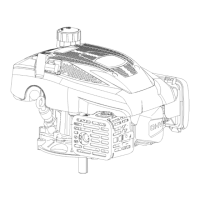3.
Pull
the
starter
grip
lightly
until
resistance is
felt,
then,
briskly pull
to
syncline upper 30 degree out.
~
NOTE
Don't allow the starter grip to
snap back against the engine.
Return
it
gently to prevent damage to the starter.
STOPPING
THE
ENGINE
Push
down the engine switch
to
the OFF position.
A
CAUTION
Sudden
stopping
at
high
speed
under
heavy
load
is
forbidden, otherwise damage will result.
MAINTENANCE
THE
IMPORTANCE
OF
MAINTENANCE
Good maintenance
is
essential
for
safe,
economical,
and
trouble-
free operation.
It
will also help reduce air pollution.
A
WARNING
Improperly
maintaining
this
engine,
or failure to correct a
problem before operation, can
cause
a malfunction in
which you can
be
seriously
hurt
or killed.
Always
follow
the
inspection
and
maintenance
recommendations
and
schedules in
this
owner's
manual.
To
help you properly care
for
your
engine, the following pages
include a maintenance schedule, routine inspection procedures,
and
simple maintenance procedures using basic hand tools.
Other
service tasks
that
are more difficult,
or
require special tools, are
best handled by professionals
and
are normally performed by a
technician
or
other
qualified mechanic.
The
maintenance
schedule
applies
to
normal
operating
conditions.
If
you operate your engine under unusual conditions,
such
as
sustained high-load
or
high-temperature operation,
or
use
in unusually
wet
or
dusty conditions, consult your servicing
dealer
for
recommendations applicable
to
your individual needs
and
use.
7 I Operation & Maintenance
MAINTENANCE
SAFETY
PRECAUTIONS
Some
of
the most
important
safety precautions are
as
follows:
However,
we
cannot
warn
you
of
every
conceivable hazard
that
can arise in performing maintenance. Only you
can
decide
whether
or
not you should perform a given task.
1.
Make
sure
the
engine
is
off
before
you
begin
any
maintenance
or
repairs. This will eliminate several potential
hazards:
• Carbon monoxide poisoning
from
engine exhaust.
Be
sure there
is
adequate ventilation whenever you operate
the engine.
• Burns
from
hot
parts.
Let the engine
and
exhaust system cool before touching.
•
Injury
from
moving parts.
Do
not
run the engine unless instructed
to
do
so.
2.
Read
the instructions before you begin,
and
make sure you
have the tools
and
skills required.
3.
To
reduce the possibility
of
fire
or
explosion,
be
careful when
working around gasoline.
Use
only a nonflammable solvent,
not
gasoline,
to
clean parts. Keep cigarettes, sparks and
flames away from all fuel-related parts.
Remember
that
your servicing dealer knows your engine best
and
is
fully equipped
to
maintain
and
repair it.
To
ensure the best quality and reliability,
use
only new, genuine
parts
or
their
equivalents
for
repair
and
replacement.

